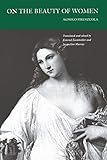On the Beauty of Women / Agnolo Firenzuola; Jacqueline Murray, Konrad Eisenbichler.
Material type: TextPublisher: Philadelphia : University of Pennsylvania Press, [2010]Copyright date: ©1993Description: 1 online resource (136 p.) : 19 illusContent type:
TextPublisher: Philadelphia : University of Pennsylvania Press, [2010]Copyright date: ©1993Description: 1 online resource (136 p.) : 19 illusContent type: - 9780812214048
- 9780812200577
- 853/.3
- online - DeGruyter
- Issued also in print.
| Item type | Current library | Call number | URL | Status | Notes | Barcode | |
|---|---|---|---|---|---|---|---|
 eBook
eBook
|
Biblioteca "Angelicum" Pont. Univ. S.Tommaso d'Aquino Nuvola online | online - DeGruyter (Browse shelf(Opens below)) | Online access | Not for loan (Accesso limitato) | Accesso per gli utenti autorizzati / Access for authorized users | (dgr)9780812200577 |
Frontmatter -- Contents -- List of Illustrations -- Acknowledgment -- Introduction -- Bibliography -- Proem -- First Dialogue -- Second Dialogue -- Notes to the Proem -- Notes to the First Dialog -- Notes to the Second Dialogue -- Index
restricted access online access with authorization star
http://purl.org/coar/access_right/c_16ec
First published in 1548, On the Beauty of Women purports to record two conversations shared by a young gentleman, Celso, and four ladies of the upper bourgeoisie in the vicinity of Florence. One afternoon Celso and the ladies consider universal beauty. On a subsequent evening, they attempt to fashion a composite picture of perfect beauty by combining the beautiful features of women they know. The standards of beauty established in the garden give way to the artistic, creative imagination of the human spirit, and the group's movement from garden to hall seems to echo the dialogue's movement from Nature to Art, from divinely to humanly created beauty.Konrad Eisenbichler and Jacqueline Murray have provided the first translation into English of Firenzuola's dialogue since the nineteenth century. In their introduction, they argue that Firenzuola's work presents a useful point of entry into the society and values of the mid-sixteenth century. In its discussion of beauty, the dialogue reveals the intersection of Neoplantonic philosophy and mathematically based artistic theory, both inherited from classical antiquity. Indeed, Firenzuola's treatise has been assessed as one of the most significant expositions of Renaissance aesthetics.
Issued also in print.
Mode of access: Internet via World Wide Web.
In English.
Description based on online resource; title from PDF title page (publisher's Web site, viewed 23. Jul 2020)


